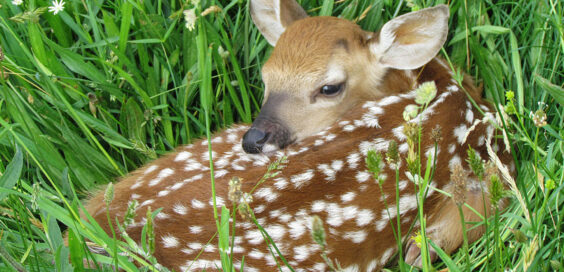
Creature Feature – Fawn Facts
Posted by Dustin Horton // May 30, 2022 // Articles, Creature Feature
This time each year, it’s good to revisit some facts about white-tailed deer fawns.
A tiny fawn often appears abandoned when we stumble across it laying on the ground with no sign of Mother around. This is rarely the case, however, and the doe is usually nearby. She leaves her fawn alone, returning to tend and nurse it. This behavior keeps it hidden from predators. The worst thing we can do is approach or touch the fawn which can result in it bolting away into danger or getting separated from its mother.
A newborn fawn also has a “freeze instinct” to escape detection. This, teamed with a nearly scentless, camouflaged coat, helps the defenseless baby avoid predators and marauding dogs. Ironically, the instinct to remain motionless can endanger the fawn, as it won’t budge, even when haying equipment or other machinery bears down on it.
Until a bond is formed with its mother, a newborn fawn will follow any large, moving object; so that seemingly cute video of a fawn toddling after a child or dog is actually a sad situation, as the fawn is led away from the doe and into danger. The best care for a fawn is with its mother. Rarely is human intervention necessary – in fact, it often proves tragic. Remember: “If you care, leave it there.”
Signs of legitimate concern include a fawn by a dead doe; visible injuries; curled ears (indicating dehydration); and incessant vocalizing. In this case, contact the NYS DEC at (607) 753-3095, extension 247 for guidance.
Margie Manthey













